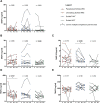Aberrant plasma MMP and TIMP dynamics in Schistosoma - Immune reconstitution inflammatory syndrome (IRIS)
- PMID: 30089120
- PMCID: PMC6101407
- DOI: 10.1371/journal.pntd.0006710
Aberrant plasma MMP and TIMP dynamics in Schistosoma - Immune reconstitution inflammatory syndrome (IRIS)
Abstract
Background: Among the different faces of immune reconstitution inflammatory syndrome (IRIS) developing in HIV-patients, no clinical definition has been reported for Schistosomiasis-IRIS (Schisto-IRIS). Although Schisto-IRIS remains largely uninvestigated, matrix metalloproteinases (MMP) and tissue inhibitors of metalloproteinases (TIMP) have previously been associated with S. mansoni infection and tuberculosis-IRIS. Here, we aimed to investigate the relevance of these markers in Schisto-IRIS.
Methodology: Patients were diagnosed with IRIS related to S. mansoni within a cohort of patients with Schistosomiasis-HIV co-infection, using a clinical working definition of Schisto-IRIS. We compared 9 patients who developed Schisto-IRIS to 9 Schisto+HIV+ controls who did not, and 9 Schisto-HIV+ controls. Plasma levels of MMP-1, MMP-7, MMP-10, TIMP-1, TIMP-2, sCD14, intestinal fatty-acid binding protein, C-reactive protein, and 8 anti-nuclear antibodies (ANA) were analyzed prior to and during 3 months of ART.
Principal findings: Although no differences were observed for MMP-1 and -7, MMP-10 levels decreased significantly in Schisto+HIV+ controls during 3 months of ART (p = 0.005) while persisting in Schisto-IRIS patients at significantly higher levels compared to Schisto-HIV+ controls (p≤0.030). In contrast TIMP-1 levels only decreased significantly in Schisto-IRIS patients (p = 0.012), while TIMP-2 levels were lower compared to Schisto+HIV+ controls at 2 weeks (p = 0.007), 1 month (p = 0.005) and 3 months (p = 0.031) of ART. Five out of 8 ANAs studied decreased significantly in Schisto-IRIS patients after 1 month of ART(p≤0.039), whereas only 1 ANA decreased for Schisto+HIV+ controls (p = 0.027).
Conclusions/significance: In this study, we propose a working definition for the diagnosis of Schisto-IRIS in resource limited settings. We report persistent plasma levels of MMP-10, along with a more pronounced decrease in TIMP-1 and ANA-levels, and low levels of TIMP-2 during 3 months of ART. Corresponding to the clinical symptoms, these data suggest that Schisto-IRIS is marked by unbalanced MMP/TIMP dynamics which favor inflammation.
Conflict of interest statement
The authors have declared that no competing interests exist.
Figures







References
-
- Meintjes G, Lawn SD, Scano F, Maartens G, French MA, Worodria W, Elliott JH, Murdoch D, Wilkinson RJ, Seyler C, John L, van der Loeff MS, Reiss P, Lynen L, Janoff EN, Gilks C, Colebunders R (2008) Tuberculosis-associated immune reconstitution inflammatory syndrome: case definitions for use in resource-limited settings. Lancet Infect Dis 8: 516–523 10.1016/S1473-3099(08)70184-1 - DOI - PMC - PubMed
Publication types
MeSH terms
Substances
LinkOut - more resources
Full Text Sources
Other Literature Sources
Research Materials
Miscellaneous

